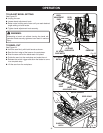
18
OPERATION
LENGTH OF CUT SCALE
See Figure 19.
The saw is equipped with a length of cut scale on its base.
It is parallel with the saw blade and can be used to measure
the distance into the material the blade cuts.
NOTE: Six inches is the maximum length of cut that you can
measure. Also, it is accurate only when the depth of cut is
set at full maximum depth.
CROSS CUTTING/RIP CUTTING
See Figures 20 - 21.
When making a cross cut or rip cut, align the line of cut
with the outer blade guide notch on the base as shown in
the figure.
Since blade thicknesses vary, always make a trial cut in scrap
material along a guideline to determine how much, if any, you
must offset the guideline to produce an accurate cut.
NOTE: The distance from the line of cut to the guideline is
the amount you should offset the guide.
To rip cut without edge guide:
Use a guide when making long or wide rip cuts with the
saw.
Secure the workpiece.
Clamp a straight edge to the workpiece using
C-clamps.
Saw along the straight edge to achieve a straight rip
cut.
NOTE: Do not bind the blade in the cut.
To rip cut with edge guide:
Secure the workpiece.
Position the face of the edge guide firmly against the edge
of workpiece.
Guide the saw along the edge to achieve a straight rip
cut.
NOTE: The guiding edge of the workpiece must be
straight for the cut to be straight. Use caution to prevent
the blade from binding in the cut.
BEVEL CUTTING
See Figures 22 - 23.
To make the best possible cut, follow these helpful hints.
Align the line of cut with the inner blade guide notch on
the base when making 45° bevel cuts.
Make a trial cut in scrap material along a guideline to
determine how much you should offset the guideline on
the cutting material.
Adjust the angle of the cut to any desired setting between
zero and 51.5°. Refer to TO ADJUST BEVEL SETTING
next.
0
1
2
3
Fig. 19
LeNgTH Of
CuT SCaLe
TOP View Of Saw
guiDeLiNe
BLaDe
guiDe NOTCH
Fig. 20
Fig. 21
0
1
2
3
45
51.5
30
15
wOrKPieCe
guiDeLiNe
C-CLaMP
C-CLaMP
STraigHT
eDge


















